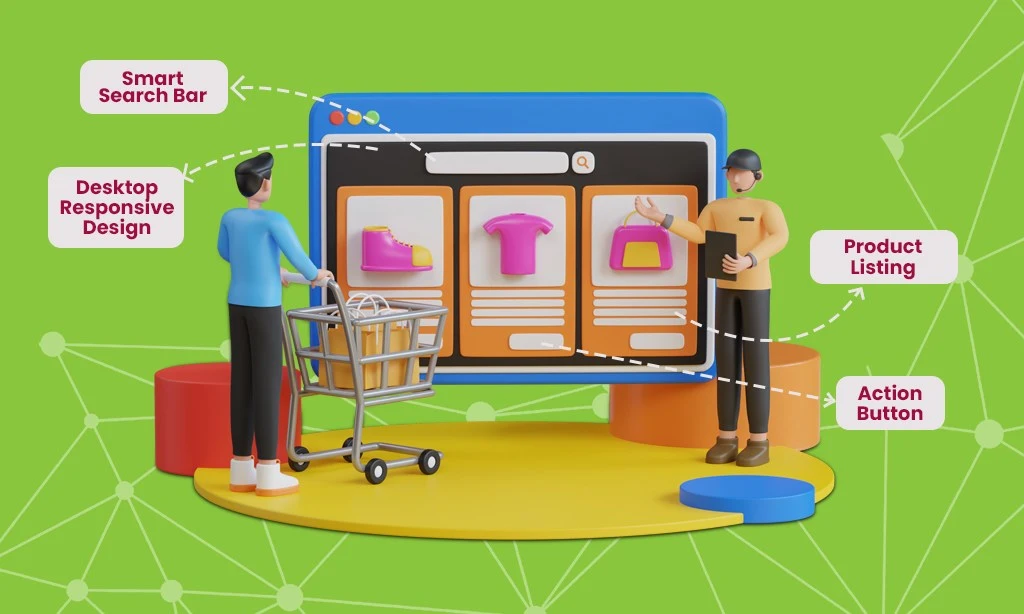WHY ECOMMERCE WEBSITE DESIGN MATTERS
eCommerce is still evolving, and eCommerce website design is one of the most important factors that affect user experience, conversions and customer retention. Mobile shopping, personalized experiences and good navigation have changed the way that online stores interact with customers. A good website structure will help users to navigate easily through the site, gain the trust of the clients and improve the shopping cart experience, which in turn results in increased sales and customer loyalty.
ECOMMERCE WEBSITE DESIGN TRENDS
MINIMALIST AND CLEAN LAYOUTS
A growing trend in eCommerce website design is minimalism. Modern online stores are based on a simple design with less clutter, which makes products the key focus. The simplification of the colour and typography schemes also helps to improve readability, and the whitespace helps to improve the user experience so that the customer can easily navigate through the products and make a purchasing decision.
MOBILE-FIRST DESIGN
As mobile commerce continues to grow, it is no longer a question of if or when to design for mobile devices but a question of when to design for them first. A website design for online stores has to start with responsive layouts, short loading times, and easy navigation. Brands need to create mobile-first designs to increase user engagement and to make sure that users can navigate through the site and check out with ease on their smartphones and tablets.
AI-POWERED PERSONALIZATION
AI is changing the eCommerce design trends by providing a personalized shopping experience. Recommendation systems, dynamic content and tailored promotions based on user behaviour increase customer engagement and satisfaction. When integrated, eCommerce businesses can build more relevant and engaging shopping trips for their customers through AI.
ADVANCED PRODUCT VISUALIZATION
Customers expect immersive shopping experiences, and advanced product visualization is a game changer. Features like 3d images, 360-degree views and augmented reality (AR) let shoppers interact with products in more detail. It increases decision certainty and decreases product return rates for this reason, it has become an essential part of the contemporary
DARK MODE
Dark mode is becoming more and more popular in the design of websites for online stores, it gives the site a very cool and fashionable look. Not only that, but it also helps to reduce eye strain, particularly when browsing late at night. Currently, many leading eCommerce platforms are integrating the dark mode feature to enhance user interaction.
KEY ELEMENTS OF A SUCCESSFUL ECOMMERCE WEBSITE DESIGN
USER-FRIENDLY NAVIGATION
Any eCommerce store must have a seamless navigation structure in place. They are items such as clear menus, search bars and category filters that aid the customer in locating products easily. Well planned navigation increases conversion rates by making it easy for customers to follow a path to purchase to the checkout.
HIGH-QUALITY PRODUCT IMAGES
Visuals play a great role in shaping consumer behaviour and decisions regarding buying products. It builds trust and engages the user through high-definition product images, different angles and the zoom-in feature. There is a great deal of evidence available to support the idea that a successful eCommerce website design must include product displays that are attention-grabbing and appealing to the eyes in order to increase the potential for sales.
FAST LOAD TIMES
Speed is very important in website performance and SEO rankings. It is bad for slow-loading sites as they have high bounce rates which sends customers away. There are optimization techniques that can be used to reduce the loading time of a website, including image compression, caching, and a Content Delivery Network (CDN).
SECURE AND EASY CHECKOUT
It is crucial to have a secure and seamless checkout process to reduce cart abandonment. Providing multiple trusted payment methods, guest checkout, and a simple form-filling process improves the satisfaction of the user and increases the conversion.
SOCIAL PROOF AND REVIEWS
Online credibility is added by customer reviews, testimonials and ratings. It also helps to build trust with potential customers through the use of user-generated content like customer photos and video reviews to encourage them to make informed purchasing decisions.
ECOMMERCE WEBSITE DESIGN EXAMPLES
EXAMPLE 1: INNOVATIVE PRODUCT PAGES
This is where many successful eCommerce platforms do things like implement advanced product visualization, personalized recommendations, and interactive design features to make product pages a lot more engaging. For example, AR tools are commonly integrated by fashion and furniture brands so that customers can visualize products in real-world settings.
EXAMPLE 2: SEAMLESS MOBILE EXPERIENCE
A leading eCommerce website that focuses on the mobile-first approach will provide a smooth and intuitive shopping experience. Designing optimized layouts for touch-friendly navigation and fast load times creates a user-friendly interface for the mobile shopper.
EXAMPLE 3: MINIMALIST LAYOUTS WITH FOCUSED PRODUCT DISPLAYS
Having minimal design is effective when brands are trying to sell their products without many distractions. A clean and modern look of an online store will grab the customer’s attention to the key selling points and that helps to improve the shopping experience.
TIPS FOR CREATING A FUTURE-PROOF ECOMMERCE WEBSITE
STAY UPDATED WITH DESIGN TRENDS
The eCommerce industry is always growing. Maintaining up to the mark with the emerging eCommerce design trends help keep your website fresh and current. Making changes to design elements regularly keeps you visible in a fast-growing market.
FOCUS ON ACCESSIBILITY
Having an inclusive eCommerce website design is very important as it is for everyone, including people with disabilities to use. These features include text speech support, keyboard navigation and colour contrast adjustments to make the experience friendly for any customer.
INVEST IN SCALABILITY
As your business grows, you need your eCommerce website to be able to handle growing traffic and more products. Scalable website architecture, cloud hosting and database optimization are for long-term performance and stability.
OPTIMIZE FOR SEO
Search engine optimization (SEO) is crucial for increasing organic traffic. Using relevant keywords, optimizing images, improving site speed, and keeping the design mobile-friendly will all help to improve search rankings. The best SEO practices are implemented to guarantee the long-term success of website design for online stores.
CONCLUSION
Why a Good Design Is More Than Just Looks A good eCommerce website design is not only about the design, it also enhances the shopping experience, builds trust and leads to an increase in sales. Every decision made during the design process should be to enhance usability, functionality and customer interaction.
Looking Ahead to eCommerce Design in the Future Due to the constantly developing technology, the trends of eCommerce design will keep on changing. Businesses must stay ahead of the curve by pioneering technology, improving the user experience and adapting to shifting consumer behaviour. A future-proof website design for online stores will provide a good platform for long-term success in the competitive eCommerce world.
Through these strategies, we at Rholab assist companies in achieving top-notch eCommerce website design that enables them to develop outstanding online shopping platforms.

















